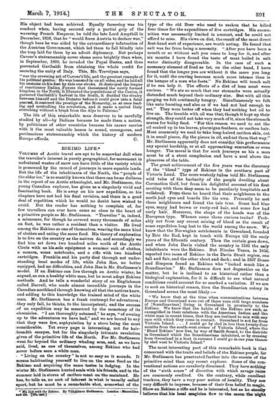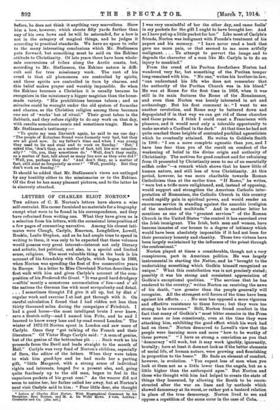ESKIMO LIFE.*
VOLUMES of Arctic travel are apt to be somewhat dull when the traveller's interest is purely geographical, for movement in nnfeatured wastes of snow can have little of the variety which is possessed by the record of journeys in more equable lands. But the life of the inhabitant& of the North, the " people of the elder ice," is so scantily known that there can bane dullness in the report of an Arctic ethnologist, and Mr. Stefibisson, the young Canadian explorer, has given ns a singularly vivid and fascinating book. He is away on his new expedition, so his chapters have not bad his final revision, and there is a good deal of repetition which he would no doubt have wished to avoid. But the reader has nothing to complain of, for few travellers can ever have come so close to the heart of a primitive people as Mr. Stehinsson. "Traveller" is, indeed, a misnomer, for though he covered many thousands of miles on foot, be was rather a resident than a visitor. He lived among the Eskimo as one of themselves, wearing the same kind of clothes and eating the same food. His theory of exploration is to live on the country as the natives do, and accordingly we find him set down two hundred miles north of the Arctic Circle with a bisaole equipment a summer suit of clothes, a camera, some notebooks, and a rifle with two hundred cartridges. Franklin and his party died through not under- standing local modes of life, while John Rae, no better equipped, had no difficulties, and John Rae is Mr. Steffinsson's model. If an Eskimo can live through an Arctic winter, be argued, wean &healthy white man, but he must adopt Eskimo :methods. And be tells a wonderful story of an Englishman called Darrell, who made almost incredible journeys in the Canadian northland through knowing all that the natives knew, and adding to this knowledge the trained.mind.of the white man. Mr. Stefinsson has a frank contempt for adventures ; they only fall, be thinks, to the incompetent; and the success of an expedition may be measured by the monotony of its chronicles. "I am thoroughly ashamed," he says, "of owning up to the adventures we have had," and we are bound to say that they were few, asphyxiation by a stove being the most .considerable. Yet every page is interesting, not for hair- -breadth escapee, but for the singularly intimate revelation given of the primitive life of the North. For Mr. Stefiination went far beyond the ordinary whaling area, and, as we have 'aid, lived, as one of themselves, among Eskimo who had never before seen a white man.
. " Living on the country " is not so easy as it sounds. It means habituating yourself to live on the same food as the Eskimo and acquiring the same tastes in lodging. In the winter Mr. Stef&nsaon hunted seals with his friends, and in the summer laid in stores of caribou meat on the mainland. He bits, be tells us, no sort of interest in what is usually called sport, but he must be a remarkable shot, somewhat of the • .1111 Life mit,. the Eakin.. By Vtilljamur Stetiasson. London Macmillan
and Oa Ph. set.]
type of the old Roar who used to -reckon that he killed four times for the expenditure of five cartridges. His ammu- nition was necessarily limited in amount, and be could not afford to miss. His views on diet, the result of the most direct first-hand sort of experience, are worth noting. He found that salt was far from being a necessity. "After you have been a month or so without salt you cease to long for it, and after six months I have found the taste of meat boiled in salt water distinctly disagreeable. In the case of such a necessary element of food as fat, on the other hand, I have found that the longer you are without it the more you long for it, nntil the craving becomes much more intense than is the hanger of a man who feats." No Eskimo will touch salt if he can help it. The effects of a diet of lean meat were curious. " We ate so much that our stomachs were actually distended much beyond their ordinary size. But with all this gorging we felt continually hungry. Simultaneously we felt like unto bursting and also as if we had not 'had enough U. eat." They were better off when they had nothing but oil to live on. The trouble with oil was that, though it kept up their strength, they could not take very much of it, since the stomach craves for bulky food. "For this reason we used to eat the oil soaked up in tea leaves, ptarmigan feathers, or caribou hair. Moat commonly we used to thke long-haired caribou akin, cut it in small pieces, dip the pieces in oil, and eat them that way." Mr. Stefinsson apparently does not consider: this performance any special hardship, or at all approaching starvation or even hunger. The moral is that for such journey& as his a man most be of a stout complexion and have 'a soul above the pleasures of the table.
The great achievement of the five years was the discovery of the "blond " type of Eskimo in the southern part of Victoria Land, The more westerly tribes told Mr. Stehineson wild tales of the barbarity of the people dwelling about Coronation Gulf, but from his delightful account of his first meeting with them they be peculiarly hospitable and wellabred: From them he beard that their neighbours to the nortli.hzd eyes and beards like his own. Presently he met these neighbours and found the tale true. Some had Wee eyes, many had brown or rusty-red hair, and some few hga curly hair., Moreover, the shape of the heads was of the European type. Whence came these curious traits ? Prob.. ably not from any recent mixing of blood as the result of some expedition long lost to the world among the snow. We know that the Norwegian settleMents in Greenland, founded by Eric the Red, kept in touch with Europe till the early years of the fifteenth century. Then the curtain goes down, and when John Davis visited the country in 1585 the only inhabitants were the Eskimo. But Nicolas Tunes, in 1656, reported two races of Eskimo in the Davis Strait region, one tall and fair, and the other short and dark; and in 1837 Deese and Simpson found an Eskimo who "looked much like a. Scandinavian." Mr. Steffineson does not dogmatize on the matter, but he is inclined to an historical rather than a biological explanation, for it is difficult to see what natural conditions could account for so marked a variation. If we are to seek an historical reason, then the Scandinavian colony in Greenland seems the most likely :- " We know that at the time when communications between Europe and Greenland were cut off there were still large numbers of [Scandinavians] living in Greenland in proximity to the Eskimo. We know that the habits of the Eskimo are stich, as exemplified in their relations with the American Indian and the white man in recent times, that they are inclined to mix with &ny- e:tee with which they come in contact. Greenland is not far. from Victoria Island. . . . I could go by sled in less than twenty-four months from the south-west corner of Victoria Island; where the Blond Eskimo' now live, by way of Smith Sound, to the districts in Greenland which the Scandinavians inhabited, or by crossing- from Greenland in a boat in summer I could go in one year them* by sled west to Victoria Island."
The most interesting part of this remarkable book is that concerned with the traits and beliefs of the Eekimo.people. for Mr. Stefinason has penetrated further into the secrets of the primitive mind than any recent explorer. Some of the cone ventional notions are cavalierly dismissed. They have nothing of the "sixth sense" of direction with which savage race* are commonly credited. On the contrary, while excellent trackers, they have a very poor notion of locality. They are very difficult to impress, because of their firm belief in magic. Show an Eskimo a rifle and he is interested, but as lie stoutly believes that his local magician flew to the moon the night before, he does not think -it anything very marvellous. - Show Lim a bow, however, which shoots fifty yards, further than any of his own bows and he will be astonnded, for a bow is not in the category of magical things, and be judges it according to practical standards. We have no space to refer to the many interesting conclusions which Mr. Stefineson puts forward, but something must be said on the Eskimo attitude to Christianity. Of late years there have been whole- sale conversions of tribes along the Arctic coasts, but, according to Mr. Stefausson, the Eskimo nature is diffi- cult soil for true missionary work. The root of his creed is that all phenomena are controlled by spirits, and those spirits are controlled in turn by charms, and this belief makes prayer and worship impossible. So when the Eskimo becomes a Christian it is usually because he recognizes in the missionary a bigger magician than the home- made variety. "His prohibitions become taboos ; and as miracles could be wrought under the old system of formulae and charms, so the Christian religion among them becomes one not of ' works' but of ritual." Their great taboo is the Sabbath, and they refuse rigidly to do any work on that day, with results sometimes comic and sometimes tragic. Here is Mr. Stefansson's testimony :—
"To quote my man Ilavinirk again, he said to me one day:
The people of Kotzebue Sound were formerly very bad, but they are all good now. In my father's time and when I was young they used to lie and steal and to work on Sunday.' But,' I asked him, 'don't they, as a matter of fact, tell lies now occasion- ally?' Oh, yes, they sometimes do.' Well, don't they really, as a matter of fact, tell about as many lies now as they ever did ? ' ' Weil, yes, perhaps they do.' And don't they, as a matter of fact, still steal as frequently as ever ? "Well, possibly. But they don't work on Sunday.'" It should be added that Mr. Stetinsson's views are untinged by any hostility either to the missionaries or to the Eskimo. Of the first be has many pleasant pictures, and to the latter he
is sincerely attached.















































 Previous page
Previous page